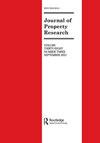A machine learning approach to big data regression analysis of real estate prices for inferential and predictive purposes
IF 2.3
Q2 URBAN STUDIES
引用次数: 55
Abstract
ABSTRACT The hedonic price regressions have mainly been used for inference. In contrast, machine learning employed on big data has a great potential for prediction. To contribute to the integration of these two strategies, this article proposes a machine learning approach to the regression analysis of big data, viz. real estate prices, for both inferential and predictive purposes. The methodology incorporates a new procedure of selecting variables, called ‘incremental sample with resampling’ (MINREM). The methodology is tested on two cases. The first is data from web advertisements selling used homes in Colombia (61,826 observations). The second considers the data (58,888 observations) from a sample of the Metropolitan American Housing Survey 2011 obtained and prepared by a reference study. The methodology consists of two stages. The first chooses the important variables under MINREM; the second focuses on the traditional training and validation procedure for machine learning, adding three activities. In both test cases, the methodology shows its value for obtaining highly parsimonious and stable models for different sample sizes, as well as taking advantage of the inferential and predictive use of the obtained regression functions. This paper contributes to an original methodology for big data regression analysis.基于推理和预测目的的房地产价格大数据回归分析的机器学习方法
摘要:享乐价格回归主要用于推理。相比之下,大数据上的机器学习具有很大的预测潜力。为了促进这两种策略的整合,本文提出了一种机器学习方法来对大数据(即房地产价格)进行回归分析,用于推理和预测目的。该方法采用了一种新的选择变量的程序,称为“重新采样的增量样本”(MINREM)。该方法在两个案例中得到了验证。第一个数据来自哥伦比亚出售二手房的网络广告(61,826个观察结果)。第二个考虑的数据(58,888个观察值)来自2011年大都会美国住房调查的样本,并通过参考研究获得和准备。该方法包括两个阶段。首先选取MINREM下的重要变量;第二部分侧重于机器学习的传统训练和验证过程,增加了三个活动。在这两个测试用例中,该方法显示了它在获得不同样本量的高度简洁和稳定的模型以及利用所获得的回归函数的推理和预测使用方面的价值。本文为大数据回归分析提供了一种新颖的方法。
本文章由计算机程序翻译,如有差异,请以英文原文为准。
求助全文
约1分钟内获得全文
求助全文
来源期刊

Journal of Property Research
URBAN STUDIES-
CiteScore
3.80
自引率
5.30%
发文量
13
期刊介绍:
The Journal of Property Research is an international journal. The title reflects the expansion of research, particularly applied research, into property investment and development. The Journal of Property Research publishes papers in any area of real estate investment and development. These may be theoretical, empirical, case studies or critical literature surveys.
 求助内容:
求助内容: 应助结果提醒方式:
应助结果提醒方式:


